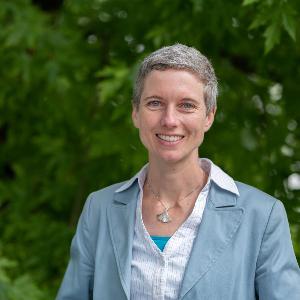Climate change: A race against the clock
29 Oct 2021
Changes in land use, together with sequestration of atmospheric carbon dioxide, can help limit the rise in global temperature. Julia Pongratz is studying both.
29 Oct 2021
Changes in land use, together with sequestration of atmospheric carbon dioxide, can help limit the rise in global temperature. Julia Pongratz is studying both.

Dead spruce trees, caused by the bark beetle, high temperatures, water shortage and climate change, near Arnsberg, Germany | © IMAGO / Jochen Tack
In essence, it’s an attempt to turn the clock back. In spite of all appeals and agreements to put a brake on climate change and restrict the rise in global temperature to 1.5°C, human activities continue to emit too much carbon dioxide (CO2) into the atmosphere. “We have no more leeway. We have, to all intents and purposes, already used up our emissions budget,” says Julia Pongratz.
Pongratz holds the Chair of Physical Geography and Land-Use Systems at LMU. Her research focuses on a strategy in which great hopes are currently being placed – the removal of carbon dioxide from the atmosphere – for re-utilization or for storage in long-lived reservoirs.
Pongratz will present the results of her research at the upcoming World Climate Conference in Glasgow. As a member of the Steering Committee of the Global Carbon Project, a worldwide association of climate researchers, she will review the annual budget for global emissions. The concentration of CO2 in the atmosphere rose to record heights again last year – the reduction in fossil CO2 emissions owing to the effects of the coronavirus pandemic were not nearly enough to prevent an overall increase. Since then, climate researchers have noted – with growing dismay – that many of the economic recovery programs initiated in response to the pandemic are incompatible with agreed national emission targets for the mitigation of climate change.
“It is quite clear that, since the middle of the 20th century, fossil-fuel emissions have become the more pressing problem with respect to climate change. But land use also accounts for a substantial fraction of emissions.Julia Pongratz
The natural carbon cycle regulates the level of CO2 present in the atmosphere – which has remained below its current concentration for at least the past 2 million years. Human activities have drastically upset this equilibrium. Humans are responsible for the rapid rise in the concentration of CO2, and our activities now produce emissions amounting to 40 billion tonnes a year. The majority of these man-made emissions are caused by the energy sector and industry. “It is quite clear that, since the middle of the 20th century, fossil-fuel emissions have become the more pressing problem with respect to climate change. But land use also accounts for a substantial fraction of emissions,” Pongratz points out. – In the case of CO2, it amounts to 15% of the total. When one also considers greenhouse gases such as methane and nitrous oxide – which are byproducts of cattle rearing and fertilizer application – this figure rises to about 25%.
Julia Pongratz’ research is concerned with finding better ways to accurately quantify the emissions associated with land use and forestry, as the level of emissions depends on what is planted, and whether croplands was created by forest clearance – which itself has an impact on the carbon budget. She also studies potential methods for the removal of CO2 from the atmosphere in this context. These include traditional measures such as reforestation, as well as new technologies such as the storage of CO2 in rock formations. All of these approaches have drawbacks and involve risks. In particular, there is no comprehensive framework in which to “evaluate possible conflicts between biodiversity, water supplies, recreational value, economic considerations and much more,” she says.

research focuses on the development of methods for the precise estimation of the contribution of agriculture and forestry to carbon dioxide emissions, and the potential ability of land-use systems to absorb the gas from the atmosphere. | © LMU
Germany has set itself the target of achieving greenhouse gas neutrality (i.e. emitting no more CO2 than can be absorbed) by 2045. “Also to achieve the further goal of 'negative emissions‘, which Germany aims to do after 2045, ways must be found to permanently remove CO2 from the atmosphere,” Pongratz points out. “And this must be done in a fashion that is socially acceptable and both ecologically and economically practical.”
So far, humanity has been slow at taking the measures necessary to reach the climate targets that have been agreed, which could limit the rise in global temperature. – And efforts to sequester CO2 are unlikely to give us much more time to do so. So climate researchers like Julia Pongratz must continue to explain the implications of their insights, but also to warn the world to take effective action. “We know that we are still releasing too much CO2, and without rapid, substantial and continuous reduction of emissions, the goals set by the Paris Agreement cannot be achieved.”
World Climate Conference: 31 October to 12 November 2021. Registration for a livestream with Julia Pongratz on 12 November here
Global Carbon Project
Minx, J. C., Lamb, W. F., Andrew, R. M., Canadell, J. G., Crippa, M., Döbbeling, N., Forster, P. M., Guizzardi, D., Olivier, J., Peters, G. P., Pongratz, J., Reisinger, A., Rigby, M., Saunois, M., Smith, S. J., Solazzo, E., and Tian, H.: A comprehensive and synthetic dataset for global, regional, and national greenhouse gas emissions by sector 1970–2018 with an extension to 2019, Earth Syst. Sci. Data, 13, 5213–5252, https://doi.org/10.5194/essd-13-5213-2021, 2021